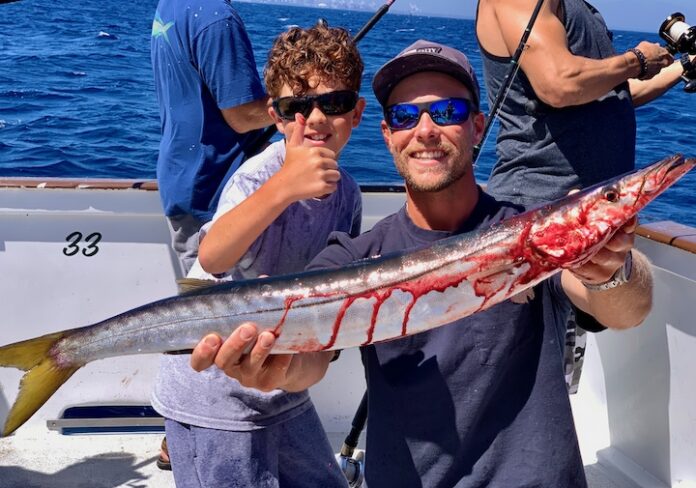
By Jon Dickens
Well, it finally happened. The barracuda have been showing in the northern and southern parts of SoCal, but seemed to bypass the San Pedro/Long Beach area – until now! I was fortunate to get out on the Victory out of Long Beach Sportfishing on the second day they showed, and got a reminder of what the “old days” used to be like.
The water temps on the Horseshoe Kelp had moved up to the mid-60’s and the water was a clean gorgeous blue color that just looked downright fishy. Current and conditions looked good and hopes were high. One of the big keys to getting the barracuda to bite however is having the right bait – anchovies. So when the Provider bait boat set us up with scoops of great anchovies, we had the ammunition to get the barracuda fired up. The boats that didn’t have the ‘chovie chum did not fare as well as the Victory did.
Victory Captain Phil Ornelas put us over the fish and the chum kept the barries biting the surface iron pretty steadily all morning, but not wide open. Once the bite slowed down to a pick, we went out and did the sculpin thing and got that out of the way to put something in everyone’s sack. Then we ran back inside and Phil put us on the alpha spot at the Shoe, and the fish went off!
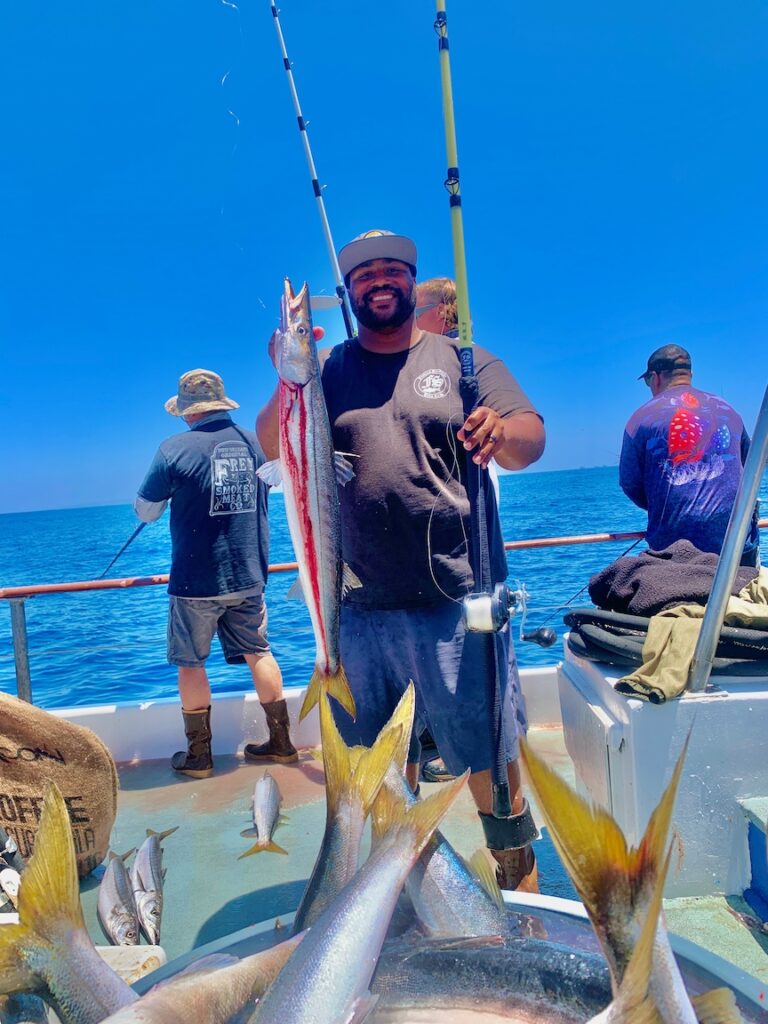
Iron slinging tips
If you had a jig that swam well and you could fire it a good distance from the boat, you were bit, or you’d at least have one or two cuda chasing your jig back to the boat. The key was throwing the smaller surface irons. The Tady C and A1 were the hot jigs. They better match the size of the anchovy chum and were what the slime sticks wanted. Getting the right speed and cadence figured out separated those catching fish, from those just practicing casting. The catchermen were working their jigs verrry slowly.
Generally speaking, if you’re not getting bit, or you’re getting short-bit, slow it down. And if you’re still not getting bit, let the jig sink for 10 seconds or more before you start your retrieve. This is a good tip if the boils stop or slow down. The fish will sometimes sink out a bit. And sometimes, the bigger logs will sit below the fray and wait for the injured baits to fall into their lap. If letting your jig sink and winding it slowly back to the boat doesn’t work, it’s time to try another iron.
Color is generally not as important as action so find a jig that swims well. The hot ticket for me was a Tady C single hook in mint and white. The single hook jigs sometimes swim with a little tighter wobble than those with a treble hook. Experiment until you find what they want. Single hook jigs also make it a lot easier to unhook those toothy critters.
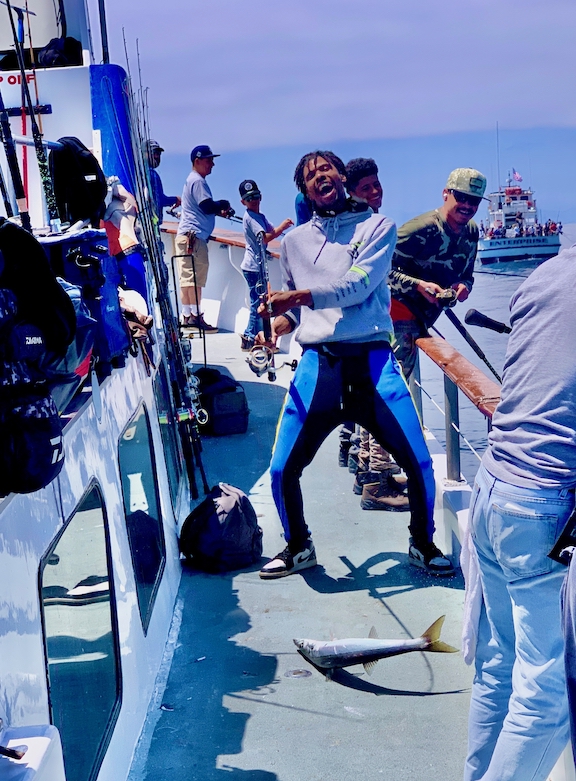
Cautionary tails
A word of warning. While most of the time, jig throwers are kept out of the stern and fish on the bow, when things get crazy and the barries are boiling in the chum line, exceptions are made. There were lots of jig slingers in the stern and a few close calls when excited anglers didn’t look behind them before casting, or someone wasn’t paying attention when the “going out” yell was made to warn fellow anglers that they’re about to cast. It’s up to the caster and the other passengers to be on high alert for flying jigs. Always, always, look behind you when you’re about to cast. As the saying goes, you can’t miss the ocean, but you can miss seeing another angler walk into your line of fire. Equally important when moving around on the deck is to always look around to see if anyone is about to cast near you. Be on the defensive and stay safe.
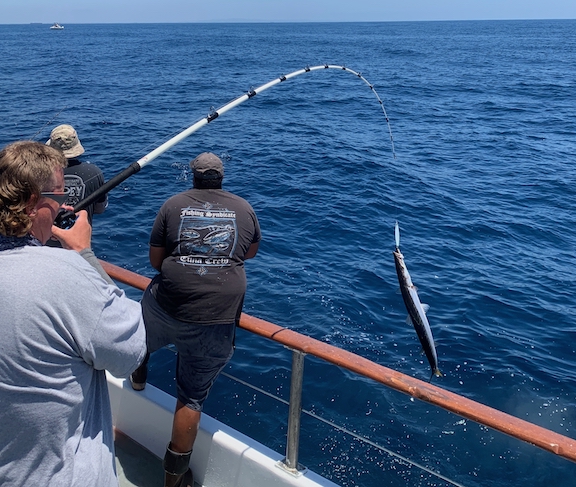
Incoming
Similarly, most of the barracuda caught on jigs are bounced over the rail and are tantamount to incoming missiles. One of these misguided missiles can do lots of damage. The proper way to bounce a fish is to wind down to it once it’s at the boat, leaving about a foot or two of line from the tip of your rod to the fish, look behind and to the sides of you and yell “incoming” or something similar to warn others you’re bouncing a fish. If possible, take a step back as you lift the fish over the rail and put your thumb on the spool and flip the reel into free spool once it has cleared the rail and let it drop right in front of you. If you’re standing next to someone about to bounce a fish, stay out of the way. Those barracuda do quite a dance when they hit the deck and the jig can go flying once the tension is off the line. No one wants to have a hook or the cuda’s sharp teeth end their day for them.
All the barracuda were big fish, averaging about seven pounds, with a few close to nine. Bags filled up quickly and you had to be careful walking around the deck because it was littered with big gar. A good problem to have. Everyone was hootin’ and hollerin’ as rods bent and barracuda flew over the rail. The crew stuffed extra fish into an oversized garbage pail, until it was filled to capacity. All in all, 30 anglers put on 229 barracuda. Four of us probably accounted for about 80 of them. To be honest, there were many people that were a bit intimidated by the action and the better fishermen who made it look easy, and some of them didn’t fare so well. But when they did put one on the deck, their smiles spelled out pure joy.
Round two
Being the fin addict that I am, I went out again three days later, avoiding the weekend warriors, and jumped on the afternoon run of the Monte Carlo from 22nd St. Landing with Capt. Steve Konrady at the helm. The day before they only had two barracuda for the day as a result of all the weekend boat traffic. We fared better with 49 cuda landed for 42 passengers. Though the counts weren’t great, the fish were there with plenty of opportunity for those who knew how to throw the iron.
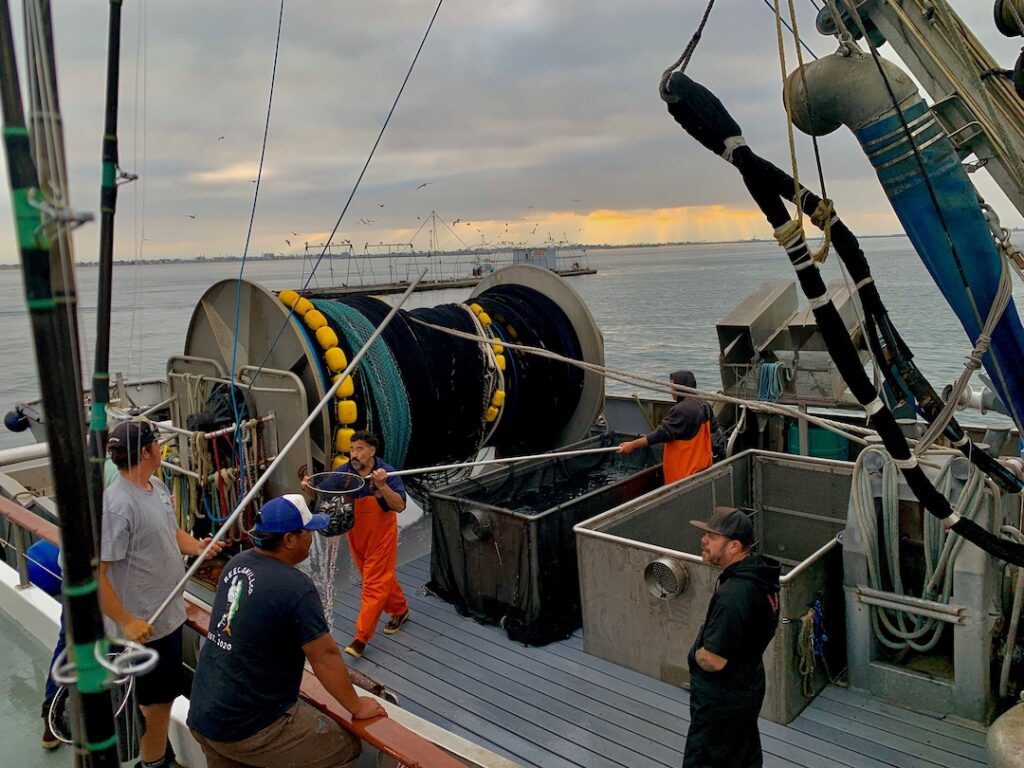
As usual, a handful of guys caught the majority of the fish. However, there was a better bait bite and a flylined sardine or an anchovy on a light slider got bit well, but there were lots of bite-offs at gaff. The standout angler by far was 9-year-old Jeremy McTeer, who landed five barracuda single-handedly on flylined baits. This young man already has amazing skills and out-fished most of the people on the boat. His father Justin told me that he started taking Jeremy on party boats at just 4-years-old and he’s already caught yellowtail, plus bluefin tuna up to 60 pounds, all on his own. Jeremy’s goal this year is to land one over 100 pounds. I’m betting he’ll do it.
If you’ve been watching the fish counts and waiting for the barracuda scores to spike, don’t wait any longer. Even if the counts are down one day, they’ll likely rebound the next. It’s time to jump on the barracuda bus and have some fun!



